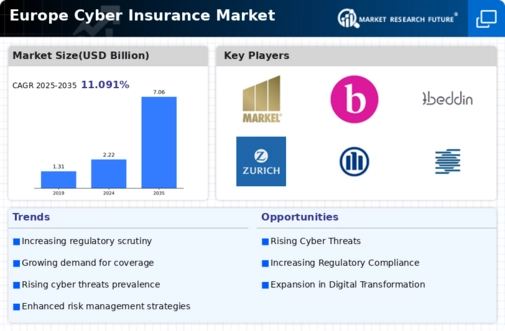The cyber insurance market in Europe is currently characterized by a dynamic competitive landscape, driven by increasing awareness of cyber risks and the growing need for businesses to protect themselves against potential financial losses. Key players such as AIG (US), Chubb (US), and Beazley (GB) are actively shaping the market through strategic initiatives that emphasize innovation and regional expansion. AIG (US) has focused on enhancing its digital capabilities, aiming to streamline the underwriting process and improve customer engagement. Meanwhile, Chubb (US) has been expanding its product offerings to include tailored solutions for small and medium-sized enterprises (SMEs), recognizing the unique challenges these businesses face in the digital landscape. Beazley (GB) has adopted a proactive approach by investing in risk management services, which not only enhances its value proposition but also fosters long-term client relationships. Collectively, these strategies contribute to a moderately fragmented market structure, where competition is intensifying as companies seek to differentiate themselves through specialized offerings and enhanced customer service.
In terms of business tactics, companies are increasingly localizing their operations to better serve regional markets, which appears to be a response to the diverse regulatory environments across Europe. This localization strategy, coupled with supply chain optimization, allows firms to respond more effectively to local market demands and regulatory requirements. The competitive structure remains moderately fragmented, with several key players exerting influence over market dynamics. The collective actions of these companies indicate a trend towards consolidation, as firms seek to enhance their market share and operational efficiencies through strategic partnerships and acquisitions.
In October 2025, AIG (US) announced a partnership with a leading cybersecurity firm to develop an integrated risk assessment tool aimed at SMEs. This strategic move is significant as it not only enhances AIG's product offerings but also positions the company as a thought leader in the cyber insurance space, potentially attracting a broader client base. The collaboration underscores the importance of integrating cybersecurity measures with insurance products, reflecting a growing trend in the industry.
In September 2025, Chubb (US) launched a new cyber insurance policy specifically designed for the healthcare sector, addressing the unique vulnerabilities faced by healthcare providers. This initiative is particularly noteworthy as it highlights Chubb's commitment to sector-specific solutions, which may enhance its competitive edge in a market where tailored offerings are increasingly valued. By focusing on the healthcare industry, Chubb is likely to capture a significant share of this niche market, which is under heightened scrutiny due to regulatory pressures and the increasing frequency of cyberattacks.
In August 2025, Beazley (GB) expanded its cyber insurance coverage to include ransomware attacks, reflecting the growing concern over this type of threat. This strategic decision is crucial as it aligns with the rising incidence of ransomware incidents across various sectors. By broadening its coverage, Beazley not only meets the evolving needs of its clients but also positions itself as a responsive and adaptive player in the market, which could enhance customer loyalty and retention.
As of November 2025, the competitive trends in the cyber insurance market are increasingly defined by digitalization, sustainability, and the integration of artificial intelligence (AI) into underwriting processes. Strategic alliances are becoming more prevalent, as companies recognize the value of collaboration in enhancing their service offerings and operational efficiencies. Looking ahead, it appears that competitive differentiation will increasingly hinge on innovation and technology, rather than solely on price. Firms that can leverage advanced technologies and maintain reliable supply chains are likely to emerge as leaders in this evolving landscape.


















Leave a Comment